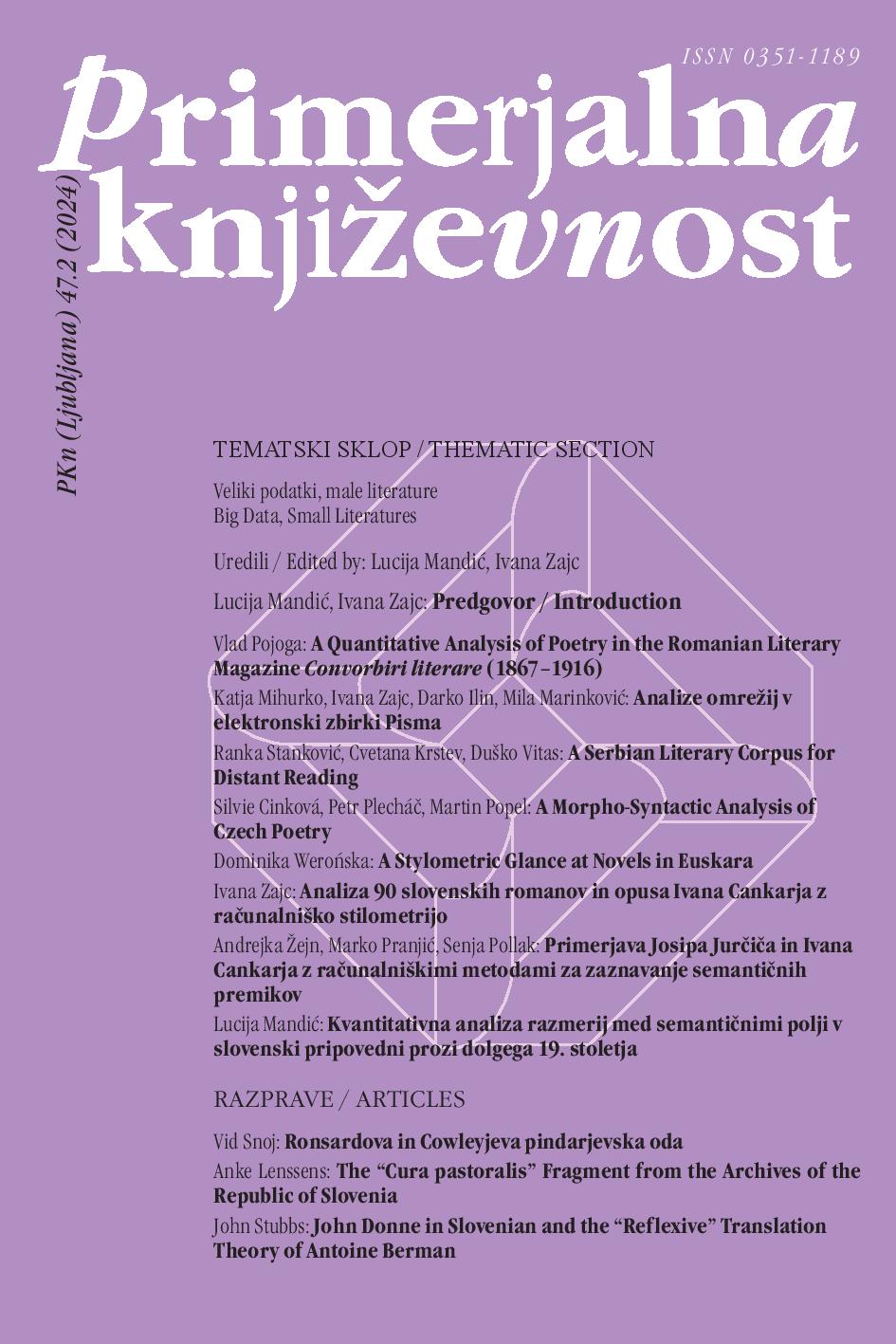The Last Bastion of European Romanticism: A Quantitative Analysis of Poetry in the Romanian Literary Magazine Convorbiri literare (1867–1916)
DOI:
https://doi.org/10.3986/pkn.v47.i2.01Keywords:
Romanian poetry, European Romanticism, poetry translation, Eminescu, Mihai, Alecsandri, Vasile, Maiorescu, Titu, quantitative analysisAbstract
The article presents a quantitative analysis of poetry published in the most popular literary periodical of modern Romania, Convorbiri literare (CL), from its founding in 1867 to 1916, when Romania entered World War I. Often seen as the last major magazine of European Romanticism, CL appeared at a time when poetry was a privileged genre in Romanian literature, and it hosted in its pages both the national poet Mihai Eminescu and nineteenth-century’s most prominent Romanian literary critic Titu Maiorescu. Arguing that the publication and theorization of poetry was an integral part of one of the last nation-building processes in Europe, the article indexes and quantitatively analyzes all forms of poetry and of what can be viewed as poetic networks in CL. By using ARCANUM’s digital archive of more than 66,000 pages of CL, three strata of poetry-related metadata are extracted and examined: the local production of poetry (who published in CL and when, and how much did they publish); poetry imports (whose poetry was translated into Romanian in CL and when, and what were the authors’ origins); and networks of influence (which foreigners were most often mentioned in relation to the two most talked-about Romanian Romantic poets of the century, Eminescu and Vasile Alecsandri). Thus, the article aims to chart the national regime of relevance that applies to Romanian modern poetry by uncovering the international network of authors who were at the center of literary debates in CL.
References
Anon. “How Do We Happily Marry Statistics and Literature?” Metacritic, vol. 1, no. 1, 2015, pp. 230–248.
Baghiu, Ștefan. “Translations of Novels in the Romanian Culture During the Long Nineteenth Century (1794–1914): A Quantitative Perspective.” Metacritic, vol. 6, no. 2, 2020, pp. 87–106.
Baghiu, Ștefan, et al. “Geografia internă a romanului românesc în secolul al XIX-lea.” Transilvania, no. 1, 2019, pp. 29–43.
Baghiu, Ștefan, et al. “Geografia romanului românesc (1933–1947).” Transilvania, no. 9, 2021, pp. 1–9.
Blakesley, Jacob. “Reading Distantly Poetry Translation: Modern European Poet-Translators.” Sociologies of Poetry Translation, edited by Jacob Blakesley, Bloomsbury Academic, 2018, pp. 197–220.
Cohen, Margaret. The Sentimental Education of the Novel. Princeton University Press, 1999.
Colescu, Leonida. Analiza rezultatelor recensământului general al populației române dela 1899. Bucharest, Institutul Central de Statistică, 1944.
Dović, Marijan, and Jón Karl Helgason. National Poets, Cultural Saints: Canonization and Commemorative Cults of Writers in Europe. Brill, 2017.
Ferber, Michael, “Introduction.” A Companion to European Romanticism, edited by Michael Ferber, Wiley, 2005, pp. 1–9.
Gonzalez-Blanco, Elena, et al. “Poetry and Digital Humanities Making Interoperability Possible in a Divided World of Digital Poetry.” EADH 2018, https://zenodo.org/records/2203807. Accessed 26 Feb. 2024.
Hasdeu, Bogdan Petriceicu. “Unu remasiagu.” Familia, no. 31, 1871, p. 368.
Hobbs, Andrew. “Five Million Poems, or the Local Press as Poetry Publisher, 1800–1900.” Victorian Periodicals Review, vol. 45, no. 4, 2012, pp. 488–492.
Juvan, Marko. “World Literature in Carniola: Transfer of Romantic Cosmopolitanism and the Making of National Literature.” Interlitteraria, no. 7, 2012, pp. 27–49.
Manolescu, Nicolae. Istoria critică a literaturii române. 2nd ed, Pitești, Paralela 45, 2019.
Mihai, Adriana. “The Politics of Online Reproduction of Shakespeare.” Transilvania, no. 8, 2015, pp. 15–21.
Moretti, Franco. “Conjectures on World Literature.” New Left Review, no. 1, 2000, pp. 54–68.
Negruzzi, Iacob. Amintiri din Junimea. Bucharest, Humanitas, 2011.
Nemoianu, Virgil. The Taming of Romanticism. Harvard University Press, 1984.
Neubauer, John. “Introduction.” History of the Literary Cultures of East-Central Europe: Junctures and Disjunctures in the 19th and 20th Centuries, vol. 1, edited by Marcel Cornis-Pope and John Neubauer, Johns Benjamins, 2004, pp. 321–324.
Nicolaescu, Mădălina, and Adriana Mihai. “Teaching Digital Humanities in Romania.” CLCWeb, vol. 16, no. 5, 2014, http://docs.lib.purdue.edu/clcweb/vol16/iss5/15. Accessed 26 Feb. 2024.
Olaru, Ovio. “What Is Digital Humanities and What’s It Doing in Romanian Departments?” Transilvania, no. 5–6, 2019, pp. 30–37.
Patraș, Roxana, et al. “The Splendors and Mist(eries) of Romanian Digital Literary Studies.” Hermeneia, no. 23, 2019, pp. 207–222.
Pojoga, Vlad. “A Survey of Poetry Translations in Romanian Periodicals (1990–2015).” The Culture of Translation in Romania, edited by Maria Sass et al., Peter Lang, 2018, pp. 99–121.
Pojoga, Vlad, et al. “Tehnici digitale pentru analiza romanului românesc.” Transilvania, no. 10, 2019, pp. 9–16.
Sapiro, Gisèle. “Publishing Poetry in Translation: An inquiry into the Margins of the World Book Market.” Sociologies of Poetry Translation, edited by Jacob Blakesley, Bloomsbury Academic, 2018, pp. 23–42.
Terian, Andrei. “Mihai Eminescu: From National Mythology to the World Pantheon.” Romanian Literature as World Literature, edited by Mircea Martin et al., Bloomsbury, 2018, pp. 35–54.
Terian, Andrei. “Big Numbers: A Quantitative Analysis of the Development of the Novel in Romania.” Transylvanian Review, Supplement no. 1, 2019, pp. 55–71.
Terian, Andrei, et al. “Genurile romanului românesc în secolul al XIX-lea.” Transilvania, no. 1, 2019, pp. 17–28.
Ursa, Mihaela. “Is Romanian Culture Ready for the Digital Turn?” Metacritic, vol. 1, no. 1, 2015, pp. 80–97.
Vancu, Radu. Elegie pentru uman: O critică a modernității poetice de la Pound la Cărtărescu. Bucharest, Humanitas, 2016.
Wu, Duncan, editor. A Companion to Romanticism. Blackwell, 1999.


